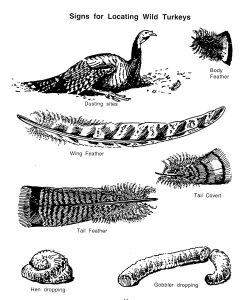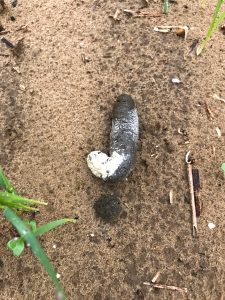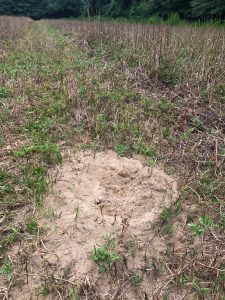For serious hunters, the seasons never end; one just runs into the next, and any gaps between them offer a chance for some scouting and gathering intelligence. While apps and trail cameras make the job easier, there’s still no substitute for boots on the ground and woodsmanship. That then involves knowing what to look for and being able to recognize it when you find it.

NWTF
Scouting for Turkeys
Scouting for turkeys is easier for several reasons. One, is that a lot of scouting can be done by ear. Still, a distant gobble may not tell you all you need to know in order to harvest that bird. And, unless you also hunt them in the fall, you probably do most of your turkey scouting in late winter and early spring, just before hunting season opens. Going too far outside that window may not be helpful as turkeys tend to change locations more from season to season than deer do. That’s why if you do hunt them in the fall, you need to scout for them in the fall as well. Fortunately, the sign is much the same.
Turkey Tracks
Tracks are helpful as they tell you where the turkeys have been, and turkeys tend to be more predictable than deer. They often, but not always follow routines, though it does vary with location and activity. In the east, they more often roost in the same trees, fly down and head for the same field. In the west, once their feet hit the ground, there’s no telling which direction they might go.
Unlike deer, you can tell sex from a turkey track. Any track longer than 4 inches from heel to the tip of the middle toe is most likely a male. And footprints aren’t the only way to tell. When a gobbler struts, he scrapes his wingtips on the ground. In soft soil, the marks show up well as lines.
Feeding
The most abundant and easily recognized turkey sign is scratching. As turkeys travel they scratch away leaves and duff to uncover food. In so doing, they leave patches of bare ground, much like deer pawing for acorns. Turkeys are much less delicate feeders than deer, and they’ll often scratch up big patches of leaves. Large areas of turned over leaves may indicate a lot of birds, or regular use. Either way, it’s a good sign.
This tells you they’ve been feeding in the area. But when? Look more closely at the leaves and the ground to determine how fresh the sign is. Are the undersides of the overturned leaves or the bare ground still moist? Or, is the ground dried out? Look also for new shoots in the bare earth, evidence the scratching may be older.
You can also tell which way the birds were traveling. As they feed, they usually travel in a more or less linear direction. When they scratch, they pull away the leaves in front of them and pile them in back. Follow them backwards and you might find the roost. Going forward might show you a mid-morning set-up spot.

Tes Jolly
Turkey Scat
Just like the tracks discussed above, you can also tell their sex from a turkey turd. The hen’s will be bulbous and round, almost like a kernel of popped corn. The males will be more cylindrical and often “J” shaped. Normally, scat is randomly deposited wherever the turkey happened to be when it defecated. If you find an accumulation, look up. It’s a very good indication you’re under a roost tree.
Turkey Dusting Bowls
The turkey’s daily routine starts with frenzied feeding. Once full, they’ll mosey off to rest and do some feather maintenance. This consists mostly of preening, but may also include a dust bath, which is believed to be a way of discouraging parasites like feather lice. They most often dust in loose sand or silt soils, making a round depression in the dirt. Find one of these and you may have a good ambush spot for quiet, midday hunting when the birds aren’t gobbling or responding to your calls.

Tes Jolly
Turkey Feathers
Over the course of your scouting trek you may find feathers. Don’t just stick them in your cap and stroll on. While they do fall out randomly, turkeys spend a good deal of time preening on the roost and at midday resting areas. Feathers could indicate either, and body feathers in or around a dust bowl will confirm it was made by a turkey.
Let’s Get Metaphysical
Most of what we’ve discussed above involves physical sign but there is a metaphysical side to scouting as well. As you spend more time scouting and finding evidence of your quarry, your subconscious mind is storing and assimilating information. Over time and with experience it develops a search image. Then one day you’re walking along and something in the back of your brain tells you to slow down and look around. You don’t see any rubs or scrapes, bare patches scratched in the leaves or tracks in the soil but somehow you know this is a hotspot. More often than not, closer inspection will reveal the physical evidence to confirm it.








